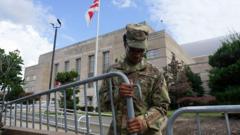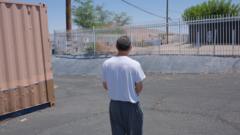Satellite imagery has confirmed that a significant reduction in the number of migrant tents at Guantanamo Bay has occurred, following a controversial expansion initiated under the Trump Administration.
Migrant Camp Expansion at Guantanamo Bay Faces Major Dismantlement

Migrant Camp Expansion at Guantanamo Bay Faces Major Dismantlement
The US has begun dismantling migrant tents at Guantanamo Bay Naval Base, revealing a shift in policy regarding migrant detention.
The US military has taken down a substantial portion of a newly established migrant camp at Guantanamo Bay, as confirmed by recently analyzed satellite imagery. The installation of tents commenced shortly after President Donald Trump's inauguration in January, with the aim to house up to 30,000 migrants deemed as threats to national security. However, the facility has failed to fulfill this capacity, with only a fraction of migrants ever held at the site.
As of mid-April, about 175 of the original 260 tents have been removed, signaling a significant reduction in operations at the site. Defense officials maintain that this is part of a strategic resource allocation rather than a reduction in readiness. The facility's construction began a day after Trump's announcement about expanding the migrant operations, signaling the urgency of this initiative.
Despite the removal of tents, it remains unclear how many detainees are currently present. High-ranking officials like Stephen Miller have affirmed the camp's ongoing operations, albeit with a much smaller population than initially anticipated. The proposed estimates suggest that the camp could accommodate fewer than 3,000 individuals, based on military regulations for sleeping arrangements.
Critics, including a group of Democratic senators who visited the site in March, have condemned the facility's existence, labeling it a misuse of military resources and a waste of taxpayer money. They highlighted that the costs of transporting migrants and maintaining detention at Guantanamo could reach tens of millions of dollars each month, prompting calls for accountability.
Since the facility's establishment, around 400 migrants have been sent there, though more than half have since been returned to the United States, while others were deported. This represents a significant deviation from Trump's initial claims of housing 30,000 migrants, raising questions about the future of the facility and its intended purpose in the current immigration landscape.























